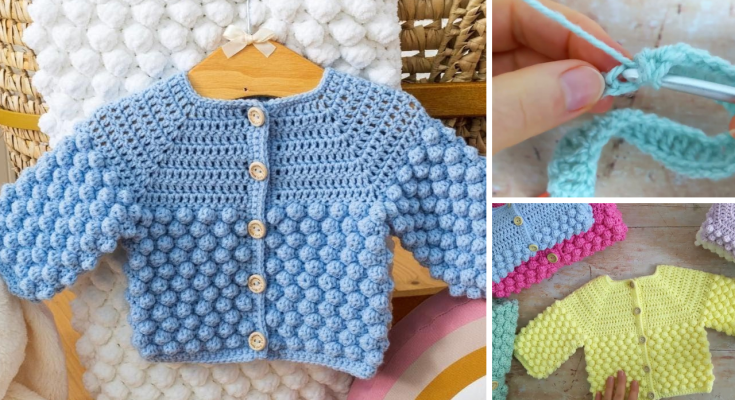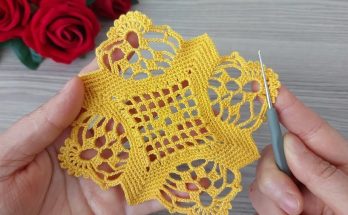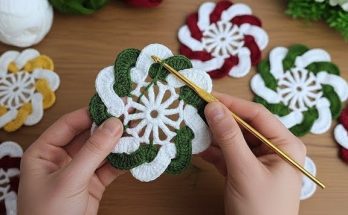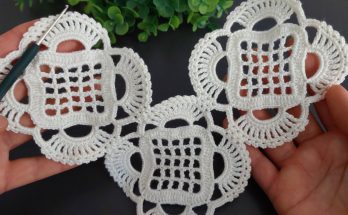Super Cute Bobble Stitch Crochet Baby Cardigan: A Touch of Texture and Charm!
There’s something incredibly charming about a baby cardigan, and when you add the delightful texture of the bobble stitch, it transforms into an undeniably super cute and cozy garment. The bobble stitch creates wonderful little “bumps” that are not only visually appealing but also add a lovely tactile quality, perfect for little fingers to explore. This makes a bobble stitch cardigan an ideal choice for a special gift or a cherished everyday piece.
This detailed tutorial will guide you through crocheting an adorable bobble stitch baby cardigan, focusing on a top-down, seamless construction that ensures a comfortable fit and minimizes finishing work. We’ll break down the bobble stitch and integrate it into a practical, stylish design suitable for both baby girls and boys.
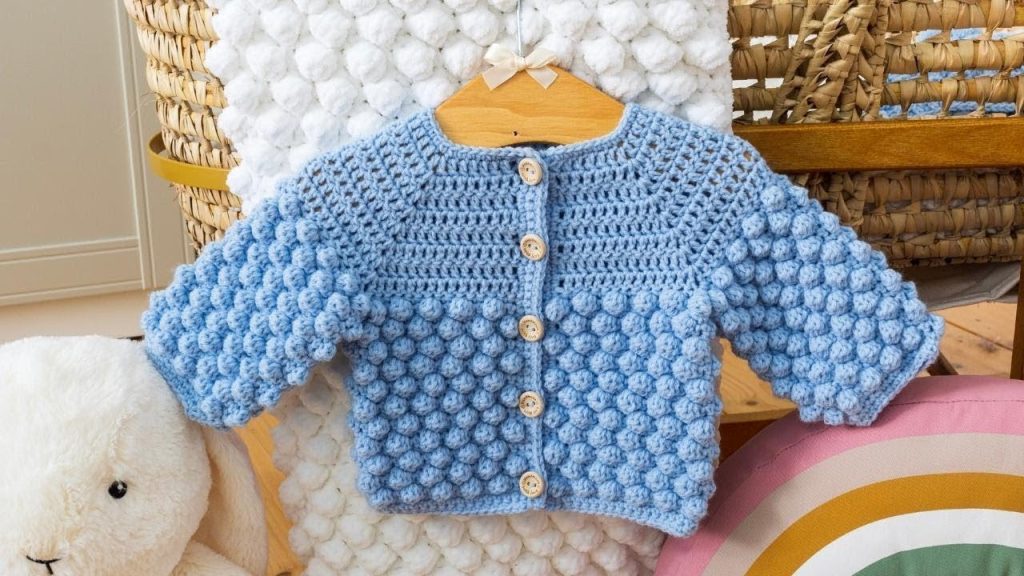
Why Crochet a Bobble Stitch Baby Cardigan?
- Irresistible Texture: The bobble stitch adds a unique, playful, and tactile element that makes the cardigan stand out.
- Warmth & Coziness: The dense nature of bobbles provides extra insulation, perfect for cooler weather.
- Charming Aesthetic: Bobbles create a sweet, whimsical look that’s perfect for babies.
- Practical Layer: Easy to slip on over onesies or tops for added warmth without restricting movement.
- Skill Enhancement: Practice top-down garment construction, raglan shaping, and mastering the bobble stitch.
- Heirloom Potential: A handmade bobble stitch cardigan is a thoughtful and enduring gift.
1. Planning Your Bobble Stitch Baby Cardigan: Size & Materials
Careful planning is the first step to a beautifully fitting and beloved cardigan.
- Size: This pattern is primarily written for Newborn (0-3 Months), with instructions on how to adjust for other common baby sizes by modifying the initial chain and yoke increases.
- Finished Chest Circumference (approx.):
- Newborn (0-3 Months): 18 inches (46 cm)
- 3-6 Months: 20 inches (51 cm)
- 6-12 Months: 22 inches (56 cm)
- 12-18 Months: 24 inches (61 cm)
- Pro Tip: Measure the baby’s actual chest for the best fit, and add 1-2 inches (2.5-5 cm) for positive ease (wiggle room) for comfort over clothes.
- Finished Chest Circumference (approx.):
- Yarn Choice (Crucial for Baby Comfort!):
- Fiber: Opt for super soft, hypoallergenic, and machine-washable yarn.
- Baby-specific Acrylic: Often labeled “baby yarn,” these are excellent choices as they’re gentle, durable, and easy to clean.
- Superwash Merino Wool: Incredibly soft, breathable, and warm, but ensure it’s specifically “superwash” for easy care.
- Cotton or Cotton Blends: Good for a slightly lighter cardigan, but choose a soft variety, as some cotton can be stiff.
- Weight: DK (Light Worsted / #3) or Worsted Weight (#4) are ideal. DK creates a more delicate fabric, while Worsted makes a cozier, faster-to-make cardigan. This tutorial uses Worsted Weight.
- Color: Solid colors or subtle variegated yarns often showcase the bobble stitch best.
- Quantity (Worsted Weight):
- Newborn: Approx. 300-400 yards (275-365 meters)
- 3-6 Months: Approx. 400-500 yards (365-457 meters)
- 6-12 Months: Approx. 500-600 yards (457-550 meters)
- 12-18 Months: Approx. 600-700 yards (550-640 meters)
- Always buy a bit extra to be safe!
- Fiber: Opt for super soft, hypoallergenic, and machine-washable yarn.
- Stitch Pattern: We’ll primarily use Half Double Crochet (HDC) for its density and warmth, with Single Crochet (SC) for ribbing, and of course, the star of the show, the Bobble Stitch (BOB).
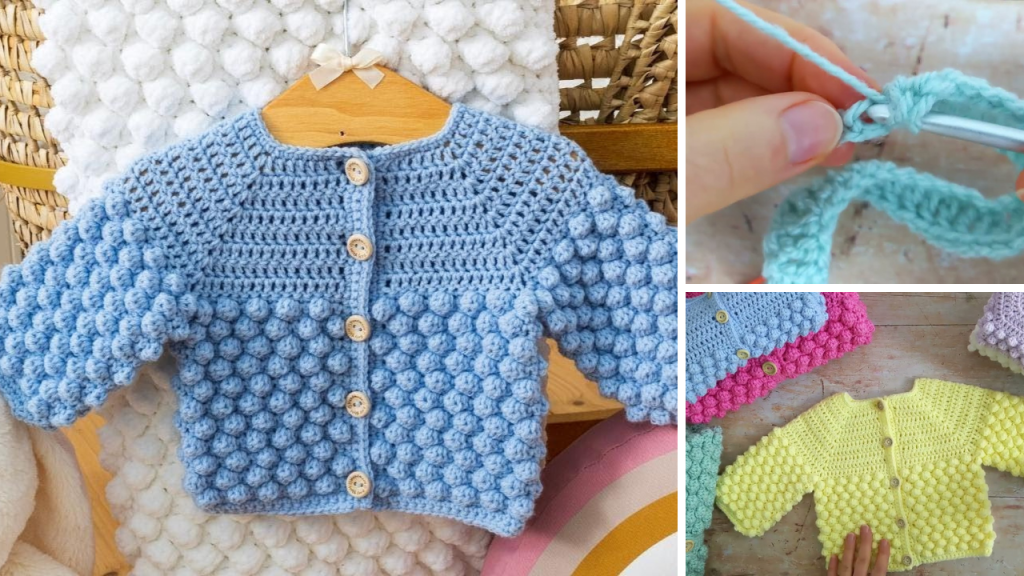
2. Materials You’ll Need
- Yarn: Your chosen quantity of Worsted Weight (#4) soft baby-friendly yarn.
- Crochet Hook: 5.0 mm (H-8 US). (Or the size needed to obtain your gauge for a dense yet flexible fabric.)
- Scissors: For cutting yarn.
- Yarn Needle (Tapestry Needle): For weaving in ends.
- Stitch Markers (Essential!): At least 4, for marking raglan increase points.
- Measuring Tape: Crucial for checking gauge and garment dimensions.
- Small Buttons (Optional): 3-5 small (0.5-0.75 inch / 1.25-2 cm) buttons for the front opening.
- Needle and Thread: For attaching buttons.
3. Essential Crochet Stitches & Techniques (Review & Practice)
Ensure you’re comfortable with these foundational stitches and garment construction methods:
- Slip Knot
- Chain (ch)
- Slip Stitch (sl st): For joining and neatening edges.
- Single Crochet (sc)
- Half Double Crochet (hdc):
- To make an HDC: YO, insert hook into stitch, YO, pull up a loop (3 loops on hook), YO, pull through all 3 loops on hook.
- Bobble Stitch (BOB): (A 5-dc bobble is common and sturdy for baby items)
- Step 1: YO, insert hook into stitch, YO, pull up a loop, YO, pull through 2 loops (2 loops on hook).
- Step 2: (YO, insert hook into the same stitch, YO, pull up a loop, YO, pull through 2 loops) 4 more times. (You will have 6 loops on your hook).
- Step 3: YO, pull through all 6 loops on your hook.
- Step 4 (Optional but Recommended): Ch 1 to close the bobble and secure it. This chain often counts as part of the stitch pattern in the next row, so check your pattern. In this tutorial, it will simply be a closing chain and not count as an extra stitch.
- Working in Rows: Turning your work at the end of each row.
- Turning Chains: Ch 2 at the start of an HDC row (counts as 1st HDC). Ch 1 at the start of an SC row (does NOT count as a stitch).
- Raglan Increases: A specific increase method to shape the shoulders and sleeves in top-down garments.
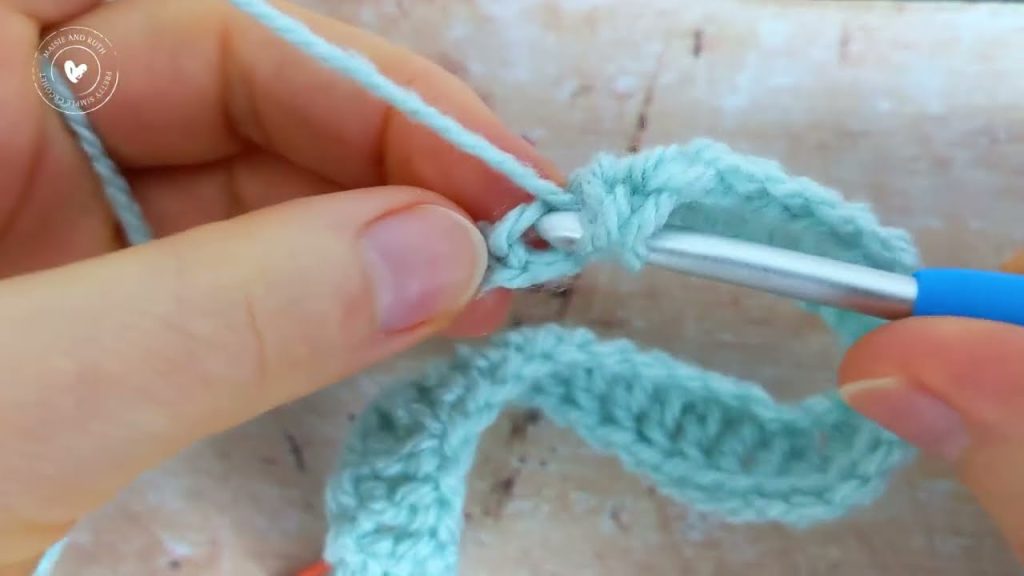
4. Gauge Swatch: Your Blueprint for the Right Fit (Crucial!)
Gauge is absolutely critical for garments, especially those with textured stitches like bobbles, to ensure the correct size and drape.
- Make a Gauge Swatch (using HDC for the main fabric, as bobbles will naturally affect gauge):
- Chain 17.
- Row 1: HDC in the 3rd ch from hook, HDC in each ch across. (15 HDC)
- Row 2: Ch 2 (counts as first HDC), turn. HDC in each HDC across. (15 HDC)
- Repeat Row 2 until your swatch measures about 4 inches (10 cm) tall.
- Measure: Lay your swatch flat. Count how many HDC stitches you have in 4 inches (10 cm) horizontally, and how many rows you have in 4 inches (10 cm) vertically.
- Target Gauge (approximate for Worsted Weight): Approximately 13-14 HDC stitches in 4 inches (10 cm) and 10-11 rows in 4 inches (10 cm).
- Adjust:
- If you have more stitches/rows per 4 inches, your tension is too tight; go up a hook size.
- If you have fewer stitches/rows per 4 inches, your tension is too loose; go down a hook size.
- Remake your swatch until you match the target gauge as closely as possible.
5. Let’s Crochet Your Super Cute Bobble Stitch Baby Cardigan! (Top-Down Construction)
We’ll start at the neckline, work the yoke, then separate for the body and sleeves. The bobbles will be added in specific rows to create a lovely pattern.
Pattern Notes:
- Ch 2 at the start of a row counts as 1 HDC unless otherwise specified.
- Increases for raglan shaping are always done in the designated corner stitch/space.
- Bobbles push to the front of your work. If you want bobbles on the right side (RS) of your fabric, you’ll need to work them on the wrong side (WS) row that precedes the RS row where they appear. For simplicity, we’ll place bobbles on one specific side to ensure consistency.
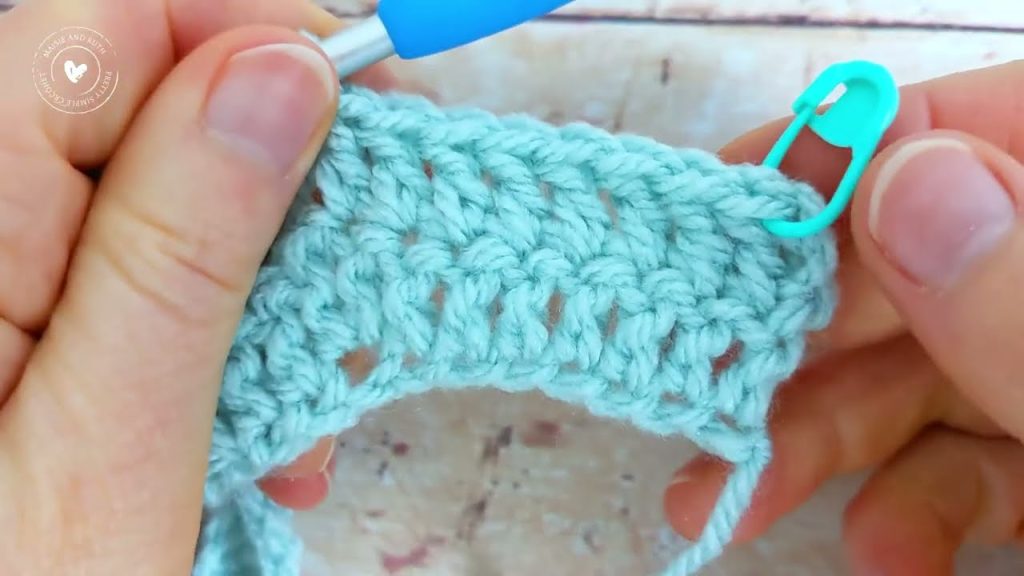
Part 1: The Yoke (Neckline & Raglan Shaping)
This forms the neckline and the increases that create the shoulders and armholes. We’ll work in rows to create a front opening for easy dressing.
- Foundation Chain (Neckline): Ch 42 (46, 50, 54).
- Newborn: Ch 42
- 3-6 Months: Ch 46
- 6-12 Months: Ch 50
- 12-18 Months: Ch 54
- Row 1 (Yoke Setup – RS): HDC in 3rd ch from hook (counts as 2 HDC).
- [Right Front Panel] HDC in next 4 (5, 6, 7) chs. Total 5 (6, 7, 8) HDC.
- [1st Raglan Corner] (HDC, ch 1, HDC) in next ch. Place stitch marker in ch-1 sp.
- [1st Sleeve Panel] HDC in next 6 (7, 8, 9) chs. Total 7 (8, 9, 10) HDC.
- [2nd Raglan Corner] (HDC, ch 1, HDC) in next ch. Place stitch marker in ch-1 sp.
- [Back Panel] HDC in next 12 (14, 16, 18) chs. Total 13 (15, 17, 19) HDC.
- [3rd Raglan Corner] (HDC, ch 1, HDC) in next ch. Place stitch marker in ch-1 sp.
- [2nd Sleeve Panel] HDC in next 6 (7, 8, 9) chs. Total 7 (8, 9, 10) HDC.
- [4th Raglan Corner] (HDC, ch 1, HDC) in next ch. Place stitch marker in ch-1 sp.
- [Left Front Panel] HDC in next 5 (6, 7, 8) chs. Total 6 (7, 8, 9) HDC.
- Total stitches: 54 (62, 70, 78) HDC + 4 ch-1 sps.
- Row 2 (Yoke Increase – WS): Ch 2 (counts as 1st HDC), turn.
- HDC in each HDC until you reach the 1st marked ch-1 sp.
- (HDC, ch 1, HDC) into the marked ch-1 sp. Move marker to new ch-1 sp.
- HDC in each HDC across the sleeve panel until you reach the 2nd marked ch-1 sp.
- (HDC, ch 1, HDC) into the marked ch-1 sp. Move marker.
- HDC in each HDC across the back panel until you reach the 3rd marked ch-1 sp.
- (HDC, ch 1, HDC) into the marked ch-1 sp. Move marker.
- HDC in each HDC across the sleeve panel until you reach the 4th marked ch-1 sp.
- (HDC, ch 1, HDC) into the marked ch-1 sp. Move marker.
- HDC in each remaining HDC across the front panel.
- Stitch count increases by 8 HDC each row (2 HDC per corner).
- Row 3 (Yoke Increase & First Bobbles – RS): Ch 2, turn.
- HDC in each HDC until you reach the 1st marked ch-1 sp.
- (HDC, ch 1, HDC) into the marked ch-1 sp. Move marker.
- HDC in each HDC across the sleeve panel until you reach the 2nd marked ch-1 sp.
- (HDC, ch 1, HDC) into the marked ch-1 sp. Move marker.
- Now, let’s add bobbles to the back panel for a central design: HDC in first 2 stitches of back panel. BOB in next st. HDC in next 2 sts, BOB in next st. Repeat from * to * across back panel (ending with 1 or 2 HDC if needed) until you reach the 3rd marked ch-1 sp.
- (HDC, ch 1, HDC) into the marked ch-1 sp. Move marker.
- HDC in each HDC across the sleeve panel until you reach the 4th marked ch-1 sp.
- (HDC, ch 1, HDC) into the marked ch-1 sp. Move marker.
- HDC in each remaining HDC across the front panel.
- Bobbles will pop out on the front side of the cardigan.
- Row 4 (Yoke Increase – WS): Repeat Row 2. (This is a plain HDC row, which helps the bobbles pop).
- Repeat Yoke Rows:
- Continue repeating Rows 2-4 (or a sequence of plain HDC rows and bobble rows as desired) for a total of 6 (7, 8, 9) increase rows.
- Newborn: 6 rows total (3 plain, 3 bobble rows)
- 3-6 Months: 7 rows total
- 6-12 Months: 8 rows total
- 12-18 Months: 9 rows total
- At the end of the final yoke row, your piece should lay relatively flat and the sleeve sections should be wide enough to comfortably fit around the arm.
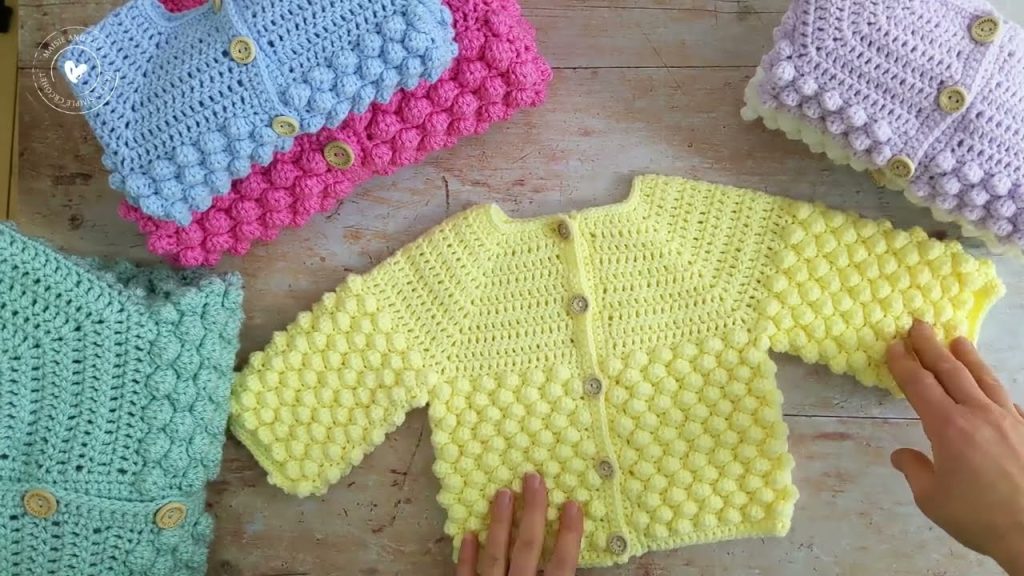
Part 2: Separating Body and Sleeves
This step defines the armholes and forms the main body of the cardigan.
- Next Row (Separation – RS): Ch 2 (counts as 1st HDC), turn.
- HDC in each HDC across the Right Front Panel until you reach the 1st marked ch-1 sp.
- (HDC, ch 1, HDC) into the 1st marked ch-1 sp.
- Skip all HDC stitches of the 1st Sleeve Panel.
- (HDC, ch 1, HDC) into the 2nd marked ch-1 sp.
- HDC in each HDC across the Back Panel until you reach the 3rd marked ch-1 sp.
- (HDC, ch 1, HDC) into the 3rd marked ch-1 sp.
- Skip all HDC stitches of the 2nd Sleeve Panel.
- (HDC, ch 1, HDC) into the 4th marked ch-1 sp.
- HDC in each remaining HDC across the Left Front Panel.
- You will now be working on the main body of the cardigan.
Part 3: The Body (Working Downwards)
Continue the HDC pattern down the body, interspersing bobble rows as desired.
- Body Row 1 (WS): Ch 2 (counts as 1st HDC), turn. HDC in each HDC across the entire body, working into the ch-1 spaces created during separation.
- Body Row 2 (RS – Bobble Row Option): Ch 2, turn.
- HDC in first 2 sts. BOB in next st. HDC in next 2 sts, BOB in next st. Repeat from * to * across the entire body. End with 1 or 2 HDC.
- Adjust spacing if you want bobbles closer/further apart (e.g., HDC in next 3 sts, BOB in next st).
- Body Row 3 (WS): Ch 2, turn. HDC in each HDC across. (This row helps the bobbles pop out and creates a smooth surface for the next bobble row if you’re alternating).
- Repeat Body Rows 2-3 (or plain HDC rows): Continue alternating bobble rows with plain HDC rows until the cardigan measures approximately 9 (10, 11, 12) inches / 23 (25.5, 28, 30.5) cm from the neckline down to the bottom hem.
- Try it on a doll or measure against the baby’s torso for the best length.
- Fasten Off, leaving a tail for weaving.
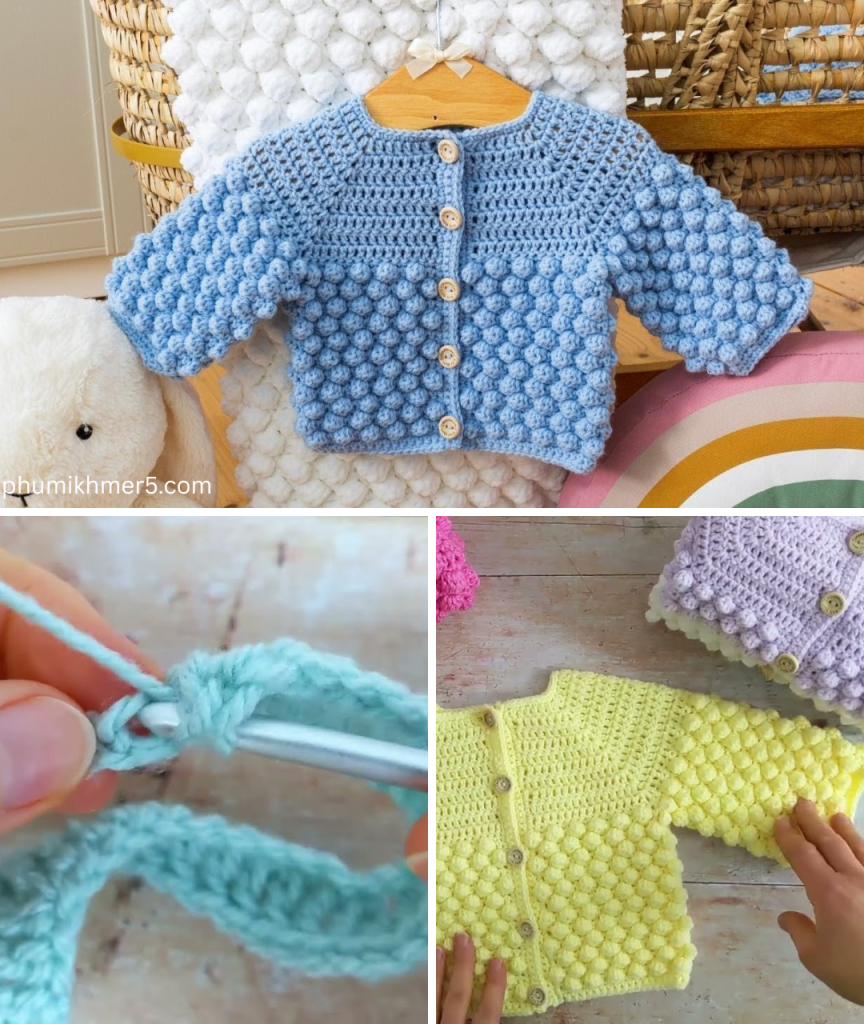
Part 4: The Sleeves (Working in Rounds)
Now add the sleeves. You can choose full-length or 3/4 sleeves.
- Join Yarn: Join yarn with a sl st in the armpit area of one armhole (e.g., in the ch-1 space formed during separation).
- Sleeve Round 1 (RS): Ch 2 (counts as 1st HDC). HDC in each HDC around the armhole, and into any ch-1 spaces. Join with a sl st to the top of the beginning Ch 2.
- Sleeve Round 2 (WS – Bobble Row Option): Ch 2, HDC in first 2 sts. BOB in next st. HDC in next 2 sts, BOB in next st. Repeat from * to * around. Join with a sl st.
- Sleeve Round 3 (RS): Ch 2, HDC in each HDC around. Join with a sl st.
- Repeat Sleeve Rounds 2-3 (or plain HDC rounds): Continue alternating bobble rows with plain HDC rows until the sleeve reaches the desired length, stopping about 1 inch (2.5 cm) short of the final cuff length.
- For a Newborn, sleeves might be 6-7 inches (15-18 cm) long from armpit to cuff.
- Cuff (Ribbed):
- Cuff Round 1: Ch 1 (does NOT count as a st). Sc in each HDC around. Join with a sl st to the first sc.
- Cuff Rounds 2-3: Ch 1, Sc in BLO of each sc around. Join with a sl st. (Creates a nice ribbed cuff).
- Fasten Off, leaving a tail for weaving.
- Repeat for the second sleeve.
6. Finishing Touches: The Cute Details
These final steps ensure a polished and functional cardigan.
- Front Opening Edging & Buttonholes:
- Join yarn with a sl st at the bottom of one front opening panel.
- Edging Row 1: Ch 1 (does NOT count as a st). Sc evenly up the front opening edge, around the neckline, and down the other front opening panel. Aim for 1 sc per HDC row end (or 2 sc for every 3 HDC rows) for a smooth edge.
- Buttonhole Row: Ch 1, turn. Sc in the first few sc sts. Ch 2 (or 3, depending on button size), sk 2 (or 3) sts. Sc in next few sts. Repeat for 3-5 evenly spaced buttonholes along one front panel (choose the right side for boys, left for girls, or vice versa if preferred). Continue sc to the end of the row.
- Final Edging Row: Ch 1, turn. Sc in each sc around, working 2 (or 3) sc into each ch-2 (or ch-3) buttonhole space. Sl st to join at the beginning.
- Fasten Off.
- Weave in All Ends: Use your yarn needle to carefully weave in any remaining loose yarn tails. For baby garments, ensure they are extremely secure and won’t come undone or pose a hazard.
- Attach Buttons: Sew your small buttons onto the front panel opposite the buttonholes, aligning them perfectly. Secure them very well with needle and thread.
- Blocking (Recommended!):
- Blocking helps even out your stitches, sets the shape, and improves the overall drape and fit of the cardigan, especially with bobbles.
- Steam Blocking (for acrylic): Lay the cardigan flat. Hover a steam iron (do not touch the iron to the yarn!) over the fabric, allowing the steam to relax the fibers. Gently pat and shape with your hands. Let cool and dry completely.
- Wet Blocking (for wool blends/cotton): Gently submerge the cardigan in cool water with a little mild soap. Squeeze out excess water without twisting. Lay it flat on a clean towel or blocking mats, shaping it to the desired dimensions. Let it air dry completely.
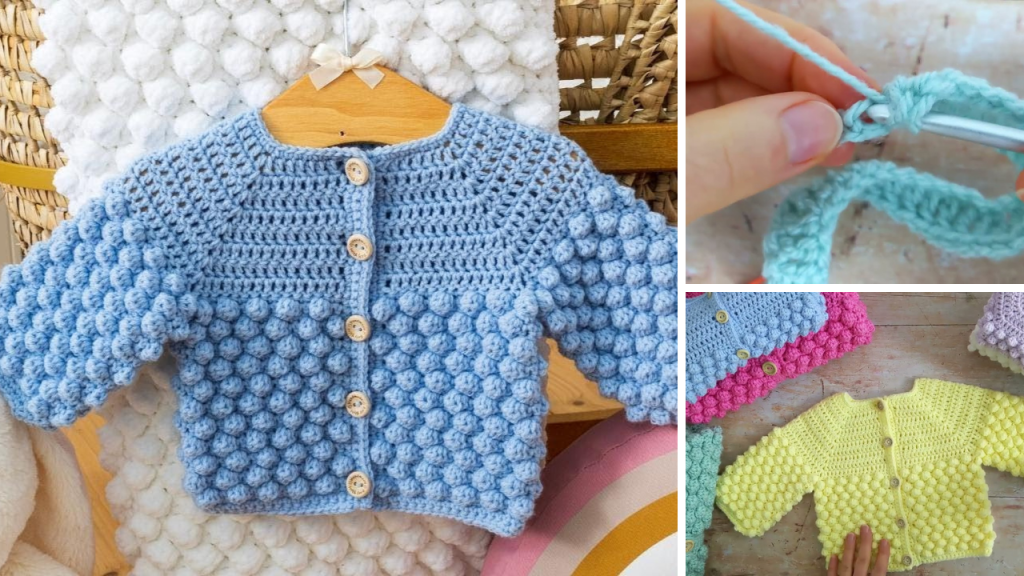
7. Care for Your Crocheted Bobble Stitch Baby Cardigan
Always refer to your yarn label for specific care instructions. For most baby-friendly yarns:
- Machine Washable: Usually machine wash on a gentle cycle in cool water. Place in a mesh laundry bag to protect the bobbles and prevent snagging.
- Drying: Tumble dry on low heat or, ideally, lay flat to air dry to maintain shape and prevent stretching.
- Avoid Bleach: Do not use bleach unless specifically instructed by the yarn label.
Congratulations! You’ve just crocheted a wonderfully cozy and super cute bobble stitch baby cardigan. This handmade garment is a truly special creation, sure to keep a little one warm and stylish, and will undoubtedly be cherished. Enjoy seeing it on your favorite baby!
Video tutorial:
